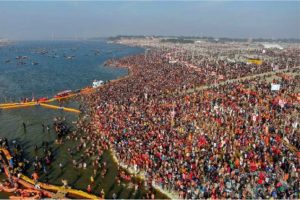JANUARY 15, 2019 
People from lands near and far braved the cold weather to take a dip in the icy waters, reaching the makeshift township of Kumbh Nagari, touted to be the world’s biggest temporary city, as early as 4 am
Hindu pilgrimage Kumbh Mela 2019
New Delhi — The biggest pilgrimage on the planet has kicked off in India.
From now until March, up to 120 million pilgrims — nearly double the population of the UK or France — are expected to travel to Prayagraj in India’s northern Uttar Pradesh state for the Kumbh Mela.
Considered the world’s largest gathering of humanity, it’s a two-month-long mass Hindu pilgrimage during which attendees symbolically wash off their sins.
One of the most striking sights of the festival is the “shahi,” or royal procession of the dramatic Hindu holy men known as “sadhus.”
Some are dressed in saffron, others sporting dreadlocks and smeared in ash as they make their way to the river to take their first holy dip.
“At the core of the festival are the camps of ‘sadhus’,” says James Mallinson, a senior lecturer in Sanskrit at London’s School of Oriental and African Studies.
“For them it’s important on an organizational level because it’s the one time they all get together. It’s the only chance for them to make big organizational decisions. At the same time, it’s a bit of a social because they won’t have seen each other (for some time).”
 The camps of “sadhus” — holy men — are a highlight of the Kumbh Mela. – Getty Images
The camps of “sadhus” — holy men — are a highlight of the Kumbh Mela. – Getty Images
Bathing in the sacred waters of the “sangam,” where the Ganges, Yamuna and Saraswati rivers meet, is believed to achieve “moksha,” or salvation, from the cycle of life and death.
“There are normally three or four days deemed to be particularly auspicious to wipe away your sins,” Mallinson tells CNN Travel.
“Some of the myths behind the festival say the water turns into ‘amrita,’ the nectar of immortality on those particular days. Ordinary pilgrims will also go to get the blessing or ‘darshan’ from these holy men.”
A modern mela
The logistics required to organize an event of this scale are mind-boggling.
In the months leading up to this year’s Kumbh Mela, the state government has ramped up development efforts.
A new airport was constructed to cope with the volume of passengers flying in from around the country.
Six special train services have been introduced within Uttar Pradesh to bring pilgrims from other parts of the state.
The State Transport Corporation has also deployed 6,000 buses to ferry pilgrims into and around Prayagraj (previously known as Allahabad).
Within Prayagraj itself, a new bathing area has been created, with 20 makeshift docks dotted across an eight-kilometer stretch of the river.
A sprawling tent city includes 87 colonies featuring simple tents with basic amenities for less financially able pilgrims. Each colony can host 2,000 pilgrims.
In addition, private agencies have set up around 4,000 premium tents with modern amenities in other parts of the town.
 An Indian devotee takes a dip on the banks of the Triveni Sangam, the confluence of the Ganges, Yamuna and mythical Saraswati rivers. – Getty Images
An Indian devotee takes a dip on the banks of the Triveni Sangam, the confluence of the Ganges, Yamuna and mythical Saraswati rivers. – Getty Images
Given the number of pilgrims coming into the area, safety is obviously a huge concern.
During the last Kumbh Mela held in Prayagraj , in 2013, a railroad station stampede in left 36 people dead.
More than 10,000 policemen will be patrolling the 32-square-kilometer pilgrimage site, which in turn will be monitored by over 1,000 CCTV cameras all linked back to a new state-of-the-art control room.
“Things function very smoothly. It’s only around the big bathing days that it’s very hectic. The rest of the time, it’s quite relaxed,” says Mallinson, who has visited the festival numerous times and has been ordained as a “Mahant” (chief priest), the first Westerner to receive this honor.
“When the British were in charge, there were often cholera outbreaks. Since then, the authorities have been focused on keeping it clean, tidy and putting a lot of chemicals down to stop infection. They’re very good about controlling the roads. It’s essential but it’s absolutely incredible.”
Mythological roots
Inscribed on UNESCO’s “Intangible Cultural Heritage of Humanity” list in 2017, the Kumbh Mela is based on Hindu mythology and a battle between Lord Vishnu, considered the protector of the universe, and demons over a pitcher containing “amrit.”
Vishnu emerged victorious, managing to take hold of the pitcher and fly off on Garuda, a large bird-like creature. According to ancient Hindu texts, as Vishnu flew away from the demons, four drops of nectar fell onto four ancient cities: Prayagraj, Nasik, Haridwar and Ujjain.
Officials expect up to 30 million devotees on February 4, the most auspicious bathing day. Known as Mauni Amavasya, this is when Rishabh Dev, considered the first sage, broke his vow of silence and bathed at the “sangam.”
The Kumbh Mela — mela means “fair” in Hindi — takes place four times within a 12-year period, alternating between four cities (Nasik, Prayagraj, Ujjain and Haridwar) every three years. The Maha (mega) Kumbh takes place in each of those cities every 12 years.
Courtesy/Source: CNN Travel











































































































